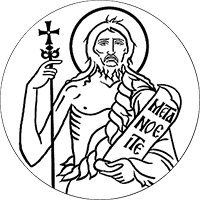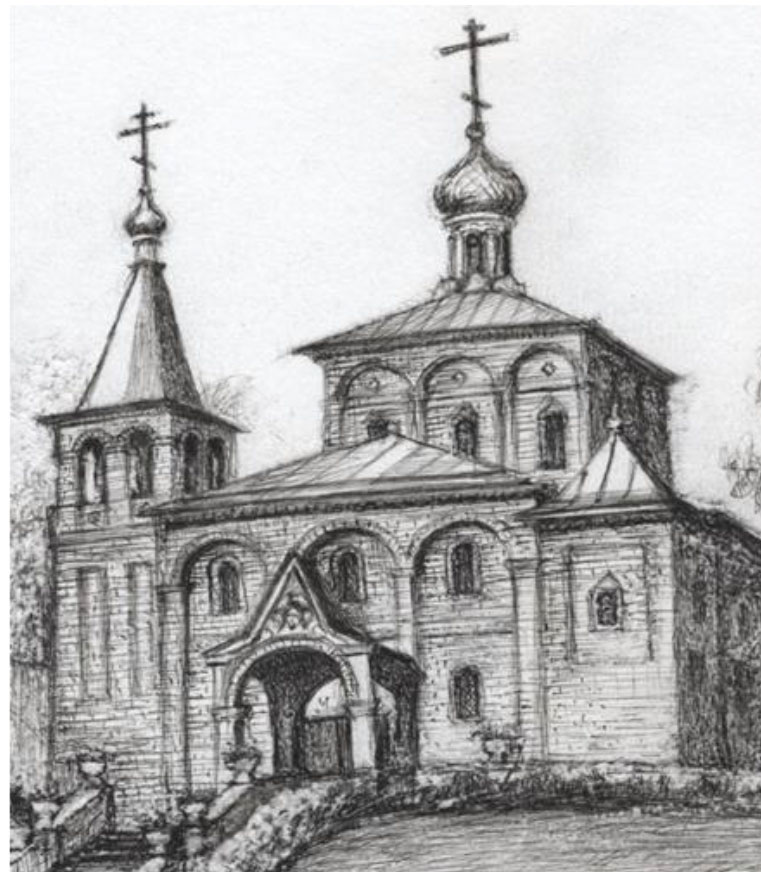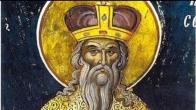You are here
Holy Hierarch St. Ignaty Brianchaninov
30 April/13 May
 The name Holy Hierarch St. Ignaty Brianchaninov shines in the chronicles of the Church in Russia with the bright light of grace-filled election, as one of the most authoritative directors of people along the path to Eternal Life.
The name Holy Hierarch St. Ignaty Brianchaninov shines in the chronicles of the Church in Russia with the bright light of grace-filled election, as one of the most authoritative directors of people along the path to Eternal Life.
Holy Hierarch Ignaty (Dimitry in Holy Baptism) was born on February 5, 1807 in the village of Pokrovskoye , in the Gryazovetsk section of Vologda District; he was born into Brianchaninov family, a family of long-standing nobility.
All of the Brianchaninov children had excellent rearing and education at home.Dimitry's teachers and instructors were amazed by his brilliant and multifaceted abilities, already evident at an early age. When the boy reached age 15, his father took him to distant Petersburg and enrolled him in a military-engineering school. The future Dimitry's parents planned for him did not suit his inclinations at all. He had already told his father that he «wanted to become a monastic,» but his father dismissed his son's unexpected desire as an unpleasant and inappropriate jest.
The young Brianchaninov's excellent preparation and exceptional abilities became evident during his entrance exams. He placed first among the 130 candidates vying for the 30 available places, and he was immediately placed in the second-year class. The talented boy's name became known to the Royal Court .Throughout his attendance at the school, the future Holy Hierarch continued to amaze his instructors with his brilliantly successful studies, and graduated as valedictorian in 1826.
At school, Brianchaninov became head of a club made up of those who revered «sanctity and honor." His unusual intellectual and moral qualities attracted professors, instructors, and fellow students alike. He became known throughout Petersburg .The Sovereign Emperor Nikolai I treated him with particular paternal care and love. Taking a very active part in the life of the future Holy Hierarch, he spoke with the youth on several occasions, in the presence of the Empress and their children.
His ancestry, rearing, and family ties, opened doors to the most aristocratic houses of the capital.While he was yet a student, Dimitry Brianchaninov was a sought-after guest at the homes of highly placed figures of secular society. He was considered to be among the best orators to appear at the home of A.N. Olenin, president of the Academy of Arts ; among those visiting his literary soirees were A. S. Pushkin, I. A. Krylov, K.N. Batiushkov, and N. I. Gneditch.By that time, Holy Hierarch Ignaty's outstanding poetic gifts had come to light.
Even at that time, Holy Hierarch Ignaty stood in stark contrast to his milieu.He did not amuse himself with the corrupting tendencies of the times or fall to the allure of secular entertainments. Later, at the age of 24, D. A. Brianchaninov became a monk, and soon thereafter an archimandrite, prior of the capital's St. Sergius Monastery, and dean of the monasteries of the Diocese of St. Petersburg; he gained renown throughout Russia .He was well acquainted with and valued Metropolitan Philaret (Drozdov) of Moscow , pre-eminent member of the Holy Synod.Many of the most prominent people in Russia sought to make his acquaintance and to receive his advice and instruction.
Everything about the future Holy Hierarch disarmed his contemporaries: his magnificent outward appearance, his graciousness, and his particular spirituality, gravity and sensible mindedness. He spiritually nourished his enormous flock, helping those seeking God on their path toward moral perfection, and revealed the beauty and grandeur of Holy Orthodoxy. His multi-faceted experience, his particular ability to see everything in spiritual terms, his profound astuteness of mind, his constant and accurate self-assessment, made him quite skilled in healing spiritual and emotional illnesses.This is what our ill contemporaries should seek out rather than running to those who practiced extrasensory perception and sorcery, quacks and charlatans.
Sensitive to any kind of fraud, Holy Hierarch Ignaty sorrowfully noted that what secular art depicted was first and foremost, evil. He held a sharply critical attitude toward literary works which acclaimed so-called "superfluous people ," "heroes" [principal literary characters], such as Lermontov's Petchorin and Pushkin's Onegin, who performed evil acts out of boredom. Considering such literature as seriously harmful to the innocent souls of youthful readers, in 1847, the Hierarch wrote a sacred account, for mass distribution, of the righteous Joseph, an Old Testament hero who was a model of purity and chastity. In his preface, he wrote, «We hope that many of Petchorin's followers will become followers of Joseph.."
By the time Archimandrite Ignaty was assigned to head the Holy Trinity-St. Sergius Hermitage, located not far from St. Petersburg , on the shores of the Bay of Finland , it had encountered a significant decline. The church and monastic cells were extremely dilapidated. The 15 monks were not noted for the strictness of their way of life. The 27 year old archimandrite had to rebuild everything anew. The monastery was built up and beautified. The divine services became exemplary. Archimandrite Ignaty paid particular attention to the monastic chants; he took care to preserve ancient liturgical melodies and their harmonization. At Fr. Ignaty's request, Fr. Peter Turchaninov, a famed liturgical composer, who during the years 1836-1841 was living in Strelno, near the Holy Trinity – St. Sergius Hermitage, worked with the monastic choir and wrote for it several of his best compositions.Likewise, M. I. Glinka, who in the last years of his life took a great interest in studying ancient liturgical melodies, composed several hymns for that choir. It pleased the Lord to have His chosen one also serve the Holy Church as a bishop, administering one of the newest and most unusual dioceses of Russia .This was the Diocese of the Caucuses and the Black Sea, established in 1843, with its cathedra in Stavropol .
Archimandrite Ignaty's consecration to the episcopate took place in the Kazan Cathedral in St. Petersburg , on October 27, 1857.After saying goodbye to the brethren of the Holy Trinity St. Sergius Hermitage, whose life he had caused to blossom, Vladyka Ignaty left for the distant Caucuses. His journey took him through Moscow , Kursk , and Kharkov ; at the time, rail service from St. Petersburg terminated in Moscow ; the rest of the way was by horse.
Most-reverend Ignaty arrived in the cathedral city of Stavropol on January 4, 1858.Governor P. A. Brianchaninov (the Holy Hierarch's brother, who later followed him to the St. Nicholas – Babayev Monastery, where he was tonsured as Monk Paul), accompanied by the city administrator, clergy and the people of God, met the new Archpastor of the Caucuses with due pomp upon his arrival. Vladyka's first words to the land of Stavropol were «Peace be unto this city.» Vladyka spoke those words in token of the fact that he had come to the much-suffering land of the Caucuses as a peacemaker, with a desire to quench the fires of war in the Caucuses, and to bring peace to a land choking on the flames of strife. There the Holy Hierarch was to remain from early 1858 until the Fall of 1861.
Vladyka Ignaty was the third bishop of the Caucuses and the Black Sea .Conditions in the enormous, newly-established diocese were different from anything he had had to deal with before he was assigned to the Caucuses.War continued to rage in the Caucuses, and the grace-filled land ran red with human blood; everywhere the sound of weeping and groaning could be heard. As the local populace was made up of people of many different nationalities and faiths, a number of religious and administrative problems entirely unfamiliar to bishops administering well-established dioceses in the center of the country had to be addressed.
In spite of all the difficulties, Holy Hierarch Ignaty earnestly took on his archpastoral duties.He saw as his most important tasks apostolic service to the flock, bringing peace to the Caucuses, and strengthening and spreading Holy Orthodoxy there.
Vladyka Ignaty made zealous efforts to establish liturgical life and normalize relations between clergy and laity. The Holy Hierarch took care to improve the daily life of the clergy, to raise its educational level, and to improve their interrelations to a level consistent with their spiritual calling. Thanks to his efforts, diocesan matters were quickly brought into good order.
During Bishop Ignaty Brianchaninov's tenure, the Stavropol Theological Seminary, established in 1846, experienced a particularly robust development, for Holy Hierarch Ignaty understood better than anyone the importance this nursery of religious education had for Holy Orthodoxy in the Caucuses;thus, he put all of his efforts into building up the Seminary.He personally oversaw the students' spiritual development, moved the seminary to a newly-erected building, and was forever remembered with thanks by its teachers and students alike as an advocate and intercessor for the Seminary before the Throne of God.
The Holy Hierarch's field of activity was not limited to the cathedral city of Stavropol .He would ride around the diocese, whose borders were the shores of the Black Sea, the Sea of Azov, and the Caspian Sea, the snowy peaks of the main ridge of the Caucuses Mountains , and the distant arid steppes of Kalmykia. The Caucuses War was going on, and the bishop always carried with him a pyx for what might be a final Communion.
In Mineralnye Vody (Mineral Springs), Holy Hierarch Ignaty Brianchaninov took the opportunity to try the healing springs of Piatigorsk, Essentuki, Goryachevodsk, and Zheleznovodsk; finding them beneficial, he blessed them.That blessing continues to be felt today, bringing physical and spiritual healing to everyone who comes seeking help; in addition to their natural healing properties, they have a special grace-filled power which treats illnesses of the soul.
On August 23, 1858, after the Divine Liturgy in the Piatigorsk Church of Our Lady Joy of All Who Sorrow, attended by civil and military authorities, important people of the city and eminent visitors to the springs, and an enormous crowd of common people, Vladyka performed the blessing of the newly-opened Lake Proval . After the walls of the grotto had been sprinkled with holy water, an icon of the Mother of God, Joy of All Who Sorrow, which had been brought in a Procession of the Cross, was installed in a niche across from the entrance.
Bishop Ignaty considered the building of churches of God in the Diocese to be of great importance.Through his efforts, in 1859 The St. John – Maria community, established by Jeremiah, first Bishop of the Caucusus was transformed into a monastery. In that same monastery, Most-reverend Ignaty founded a Church of the Protection in 1861.Along with the provincial architect Voskresensky, Vladyka himself drew up plans for a church in the village of Novo-Grigoriev that was to become a decorous enhancement to the diocese. In 1860 Vladyka Ignaty issued a construction certificate for a new church in Mozdok, in honor of the Miraculous Iveron Icon of the Mother of God which was in that town and which was greatly revered throughout the Caucuses. With the Hierarch's blessing, in two years (1859 - 1860), a unique bell-tower designed by P. Voskresensky was constructed for the Stavropol Cathedral of the Kazan Icon of the Mother of God; for many decades, it was one of the prominent attractions of the Caucuses.
Bishop Ignaty administered the Caucuses Diocese for a short time – less than four years – but that period providentially coincided with many important events in the life of the Caucuses. In 1859, Imam Shamil was imprisoned. In 1860, the Caucuses line was divided between the Kuban and Tersk Administrative Districts. In 1861, settlement of the region beyond the Kuban began.
 With God's help, Bishop Ignaty worthily performed the difficult work of administering the enormous Caucuses Diocese under the conditions of the cruel Caucuses War. Despite the military campaigns, despite the real danger of being taken hostage or killed, he visited many parishes from Taman to Kizlyar, brought order to the administrative organs of the diocese, achieved raises in salaries for the diocesan clergy, instituted a festal order of service, developed an excellent hierarchical choir, and built a bishop's residence. Moreover, he was untiring in continuing to preach. In his relations with his clergy and parishioners, Vladyka Ignaty was a true peacemaker, strict with himself, but condescending toward the weaknesses of his neighbors.
With God's help, Bishop Ignaty worthily performed the difficult work of administering the enormous Caucuses Diocese under the conditions of the cruel Caucuses War. Despite the military campaigns, despite the real danger of being taken hostage or killed, he visited many parishes from Taman to Kizlyar, brought order to the administrative organs of the diocese, achieved raises in salaries for the diocesan clergy, instituted a festal order of service, developed an excellent hierarchical choir, and built a bishop's residence. Moreover, he was untiring in continuing to preach. In his relations with his clergy and parishioners, Vladyka Ignaty was a true peacemaker, strict with himself, but condescending toward the weaknesses of his neighbors.
Because of serious illness, in the Summer of 1861, Bishop Ignaty was forced to request retirement to the St. Nicholas-Babayevsk Monastery; upon approval of his request, he and several dedicated disciples left for the Monastery on October 13.
The importance of Holy Hierarch Ignaty's written works, [passing on] the active ascetic's direct experience in establishing his spiritual life on the foundation of Sacred Scripture and the Tradition of the Orthodox Church, is inestimable. Holy Hierarch Ignaty's theological legacy was received by his readers with great love and thanks.
Even in our days, there is continued interest in Bishop Ignaty himself and in his immortal writings. Holy Hierarch Ignaty Brianchaninov is the best spiritual director, the best example of how in the whirlpool of life, one can preserve faith in Christ, constantly kindling within one's heart the flame of love and dedication to God.
Bishop Ignaty was canonized by the Local Council of the Russian Orthodox Church held at Holy Trinity-St.Sergius Lavra June 6-9, 1988. His holy relics rest in the Holy Vvedensky Monastery in Tolga, Yaroslavl Diocese.
PARISH LIFE
RECENT VIDEOS
Address of our Cathedral
Subscribe to our mailing list
While all the materials on this site are copyrighted, you may use them freely as long as you treat them
with respect and provide attribution on the Russian Orthodox Cathedral of St.John the Baptist of Washington DC.









